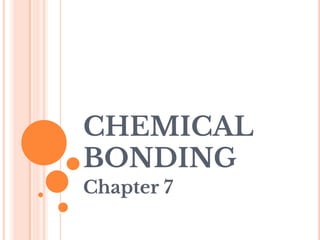
Chemical Bonding.ppt.pptx
- 2. THE OCTET RULE • Atoms tend to gain, lose, or share electrons in order to get a full set of valence electrons. • “octet” – most atoms need 8 valence electrons for a full set • Gaining or losing → ions = ionic bonding • Sharing = covalent bonding • “Dogs Teaching Chemistry” ● https://www.youtube.com/watch?v=_M9khs87x Q8
- 4. PROPERTIES OF IONIC COMPOUNDS • High melting points • Brittle • Usually salts • Many dissolve in water ● Can conduct electricity because ions separate and are charged in the solution
- 5. IONIC BONDS • Electrons are transferred from one atom to another creating ions • Cations are attracted to anions (positives and negatives attract) • Metal + nonmetal ● Metals form cations ● Nonmetals form anions
- 6. TYPES OF IONS • Monatomic = “one-atom” ● H+, Ca2+, Br-, N3- • Polyatomic = “many-atoms” ● NH4 +, OH-, SO4 2-,
- 7. LEWIS DOT STRUCTURES • Developed by American chemist Gilbert Lewis (1875-1946) • Valence electrons represented by dots around the element symbol ● No more than two dots per side • Can be used to show rearrangement of electrons during chemical reactions
- 9. BINARY IONIC COMPOUNDS • Contain ions of only two elements • Formula: Cation written first, then anion ● Charges of ions written as superscripts, # of atoms in a compound written as subscripts • Ratio written in lowest terms = empirical formula ● (REMEMBER THIS!)
- 10. BINARY IONIC COMPOUNDS • Draw the Lewis Dot Structures for sodium and chlorine • Using an arrow, identify how the transfer of 1 electron can create 2 new ions
- 11. • Sodium transfers an electron to chlorine. • Sodium becomes a positive ion with a +1 charge. • Chlorine becomes a negative ion with a -1 charge.
- 12. BINARY IONIC COMPOUNDS Na+ + Cl- → NaCl • The total (net) charge on the compound should be zero. • You must determine how many of each ion will need to be in the compound to balance out the charges.
- 13. COMPOUND FORMULA PRACTICE magnesium ion + oxide ion Mg2+ + O2- → Mg2+ + O2- → MgO calcium ion and bromide ion Ca2+ + Br- → strontium ion and nitride ion Sr2+ + N3- → Mg2O2 CaBr 2 Sr3N 2
- 14. THE CRISSCROSS METHOD FOR WRITING COMPOUND FORMULAS • Write the ion symbols (with their charges as superscripts) for the cation and anion • Criss-cross the two charges, moving them diagonally from one ion’s superscript to the other ion’s subscript ● Drop the sign!
- 15. CRISSCROSS METHOD PRACTICE magnesium ion and chloride ion Mg2+ Cl-1 Mg with Cl = MgCl2
- 16. NAMING IONIC COMPOUNDS • Name the cation using its element name. • Name the anion by dropping the ending of the element name and adding –ide. Ca3P2 calcium phosphide • If the anion is polyatomic, simply name it using the ion’s name Mg3(PO4)2 magnesium phosphate
- 17. NAMING IONIC COMPOUNDS • If the cation has more than one valence (it can have different charges), indicate the charge using roman numerals in parenthesis after the cation name. FeO = iron (II) oxide Fe2O3 = iron (III) oxide
- 18. COVALENT BONDING
- 19. COVALENT BONDS • Formed by a shared pair of electrons between two atoms • Make up molecules (which make up molecular substances) • Between nonmetals
- 20. FORMULAS • Empirical formula gives the lowest ratio of types of atoms in a compound • Molecular formula gives the exact number of atoms of each element in a single molecule of a compound • Structural formula shows how atoms are bonded together
- 21. FORMULA EXAMPLE: GLUCOSE molecular formula C6H12O6 empirical formula CH2O structural formula
- 22. LEWIS DOT STRUCTURES • For molecules: ● Show pairs of electrons that are shared between atoms using 2 dots or 1 dash. ● Leave electrons not involved in bonds as dots.
- 23. LEWIS DOT STRUCTURES Draw the Lewis dot structures for: F2 NH3 H2O H2CO C2H2
- 24. EXCEPTIONS TO THE OCTET RULE • Less than an octet ● BF3 • More than an octet ● SF4 • Odd number of electrons ● NO
- 25. PROPERTIES OF COVALENT BONDS • Polar covalent bonds = Unequal sharing ● Due to electronegativity difference ● More electronegative atom gets slightly negative charge (higher electron density) ● Less electronegative atom gets slightly positive charge (lower electron density) • Nonpolar covalent bonds = equal sharing ● No electronegativity difference
- 26. PROPERTIES OF COVALENT BONDS • Low melting points • Soft, flexible • Many won’t dissolve in water ● Cannot conduct electricity even if they do dissolve (due to no charges being present)
- 28. NAMING COVALENT COMPOUNDS (MOLECULES) • Similar to naming ionic compounds, but prefixes must be added to tell the ratio of atoms in the compound. mono- 1 di- 2 tri- 3 tetra- 4 penta- 5 hexa- 6 hepta- 7 octa- 8 nona- 9 deca- 10
- 29. NAMING COVALENT COMPOUNDS (MOLECULES) • Most electronegative element written last in formula and name. ● Drop ending of this element’s name and add –ide. Si2Br6 disilicon hexabromide • Don’t include mono- prefix for 1st element listed. CF4 carbon tetrafluoride
- 30. NAMING COVALENT COMPOUNDS (MOLECULES) • Shorten prefixes to make names easier to say. H2O dihydrogen monoxide not dihydrogen monooxide • Sometimes common names are used. O2 = oxygen NH3 = ammonia
- 31. HYDRATES
- 32. NAMING HYDRATES • Hydrates are ionic compounds that absorb water into their solid structures. ● Anhydrous substances are water-free ● Example: MgSO4 • 7 H2O